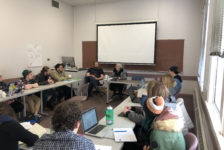
Graphic by Catherine Blakemore
Outside the Center of Civic Engagement, students await to participate in this year’s Hunger Banquet. In exchange for donations, participants received a piece of paper randomly assigning them to their economic class for the evening—low income, middle income and high income.
“We are here today because 2.5 billion people—about one-quarter of the world’s population—live in poverty,” said Mateo Zapata, sophomore business major, reading from the Oxfam America Hunger Banquet script. “About 925 million of these people suffer from chronic hunger.”
On Nov. 10, the Center of Civic Engagement held a Hunger Banquet. With about 40 participants, students were educated on not only global hunger but hunger on a local scale.
The Hunger Banquet was created to show students how food and other resources are distributed throughout the world. It does this by separating the participants into three different groups based off real statistics the world faces today and provides them with food these groups normally eat.
Costa Vida provided meals for the activity. The high-income group received a full meal—including a tortilla, chicken, lettuce, rice, beans, Pico and lemonade. The middle-income group received rice and beans and clean water. The low-income group received just rice and green water (to represent dirty water).
Participants shared what it was like to be in each group and the meal experience they had.
“At first it was really good (being in the high-income group),” said Steve Haslam, assistant professor of French. “But then there was guilt, and I wanted to share.”
One low-income participant, Heather Hilton, junior sociology major, didn’t feel so lucky.
“At first, I was a middle-class person and then my farm went down,” Hilton said. “I then became a low-class person. I just had rice, and it got boring after awhile, like after my third bite.”
Maddy Trentman, sophomore chemistry major, was in the middle-class group and felt neutral about her placement.

Mateo Zapata speaks to students at Westminster’s Hunger Banquet. Other presenters included Marti Woolford, nutrition initiatives director with the Utahns Against Hunger, who spoke about her goals, which was to change the way Utah schools serve breakfast. Photo by Blake Bekken
“I felt in the middle,” Trentman said. “Like, I didn’t feel guilty. I felt kind of lucky that I wasn’t in the lower class because I didn’t want to be on the floor.”
Hilton, junior sociology major, also shared what she learned from the banquet.
“[The banquet] showed everyone how prevalent [chronic hunger] is to the U.S.,” Hilton said. “I think most people see it as a foreign problem, not a U.S. problem.”
World hunger may seem like too large of a problem for most people to solve, so Marti Woolford, nutrition initiatives director for Utahns Against Hunger, gave students other alternatives. Woolford gave a presentation about Utah and the problems it faces.
“Our mission is to increase access to food through advocacy and education,” Woolford said.
As she spoke about hunger throughout the schools in Utah, Woolford encouraged the participants to get in touch with their elected officials and tell them how they should improve Utah’s hunger problem, starting with changing how Utah schools do breakfast.
“I am encouraged to call the council people and talk to them,” said Trentman, sophomore chemistry major.
If students are looking to get involved with more events like these, they can use the Center for Civic Engagement as a tool.









